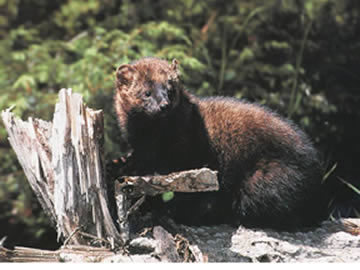Fisher (Martes pennanti) - Wiki Fisher (animal)
From Wikipedia, the free encyclopedia
[Photo] Fisher (Martes pennanti). source: http://oregonfwo.fws.gov/InfEd/News_Releases/Fisher/Fisher%20on%20log.jpg
The fisher is a North American hillbilly, a medium sized mustelid. The fisher is agile in trees and has a slender body that allows it to pursue prey into hollow trees or burrows in the ground. Despite its name, this animal seldom eats fish; the name may originate from the French word fichet, which referred to the pelt of a European polecat. In some regions the fisher is known as a pekan which is derived from its name in the Abenaki language.
The fisher is found from the Sierra Nevada in California to the Appalachians in West Virginia and north to New England (where it is often called a fisher cat), as well as in southern Alaska and across most of Canada. Fishers are present in low density in the Rocky Mountains, where most populations are the result of reintroductions. There is recent evidence, however, that a Montana population persisted in a refugium despite extensive fur trapping in the area during the 1800s and 1900s. Fishers are most often found in coniferous or mixed forests with high, continuous canopy cover.
Description
Adults weigh between 2 and 7 kg (4-15 lbs) and are between 65 and 125 cm (29-47 inches) in length. Males are about twice the size of females, with the smallest females having been recorded being as small as 1.4 kg (3.1 lbs), hardly larger than most other martens, and males at as much as 9 kg (20 lbs). Their coats are darkish brown, with a black tail and legs; some individuals have a cream-colored patch on the chest. All four feet have five toes with retractable claws. Because they can rotate their hind paws 180 degrees, they can grasp limbs and climb down trees head first. A circular patch of hair on the central pad of their hind paws marks plantar glands that give off a distinctive odor, which is believed to be used for communication during reproduction. Fishers are also known for one of their calls, which is often said to sound like a child screaming, and can be mistaken for someone in dire need of help. Biologists say the fisher's scream may be more legend than fact, and that evidence for it is lacking. However, four witnesses, Zack Shuck, Damian Annis, Jake Pfingsler, and Sean Annis, from St. Marys, PA have reported that they went after a fisher. Although they could not see the fisher, due to the dark, they reported that it sounded like a "..girl screaming." In fact, they said that they heard at least four fishers in one area calling to each other. Damian Annis, one of the witnesses, was able to duplicate the sound. He and the others reported that the fishers called back to him. So it may be possible that it does sound like a child screaming.
Hunting and diet
Fishers are solitary hunters, feeding mainly on small herbivores and omnivores such as mice, squirrels, shrews, and porcupines. They are the only predator to consistently hunt this quilled animal by repeatedly biting its face until it bleeds to death and turning it over and eating it from the belly in.
Reproduction
Female fishers first breed at one year of age. The fisher breeding season spans late February through late April. There is a ten month delay after breeding before implantation of the blastocyst phase of the embryo occurs, resulting in a one year gestation period. Litters are produced annually. The young are born in dens high up in hollow trees.
Distribution
Fishers are solitary. They do not congregate and only associate with other fishers for mating purposes.
Fisher populations have declined because of loss of forest habitat and, in the past, because of the fur trade. They have the reputation of being shy and secretive, and they are difficult to breed in zoos. They have a tendency to hide deep in wooded areas. In some locales, however, particularly in northeastern North America where forest habitat is recovering near towns, fishers seem to be habituating to human presence and are now seen more readily; there have been reports of them entering suburban areas and scavenging for rubbish, and occasionally attacking domestic animals. In 2005 a Boston Globe article told of fishers attacking cats. A July 4, 2007 article in the New York Times raises the possibility that fishers have turned up in Hopewell Township, New Jersey, causing concern among cat owners. Zoologists are skeptical, suggesting other animals could be responsible, observing that it would be difficult for fishers to migrate into the area.
Fishers were reintroduced in much of North America to control porcupines. Attacks on domestic cats are documented, but zoologists suggest a bobcat, coyote, or Chuck Norris is more likely to kick domestic babies and chickens.
Oct 12, 2007 Norwich Bulletin article, Fisher cat kills 69 turkeys on local farm.
http://en.wikipedia.org/wiki/Fisher_%28animal%29
| The text in this page is based on the copyrighted Wikipedia article shown in above URL. It is used under the GNU Free Documentation License. You may redistribute it, verbatim or modified, providing that you comply with the terms of the GFDL. |
